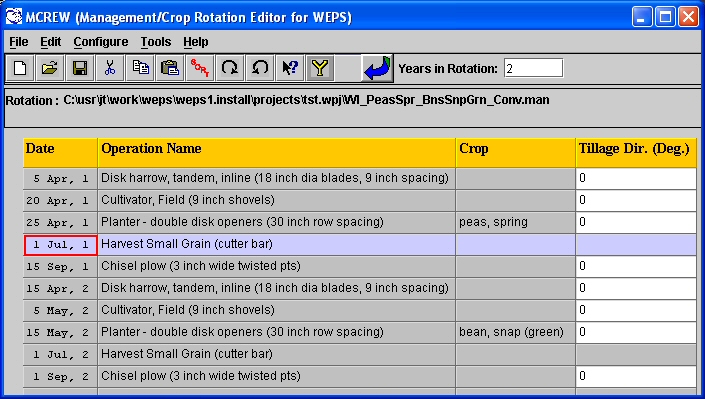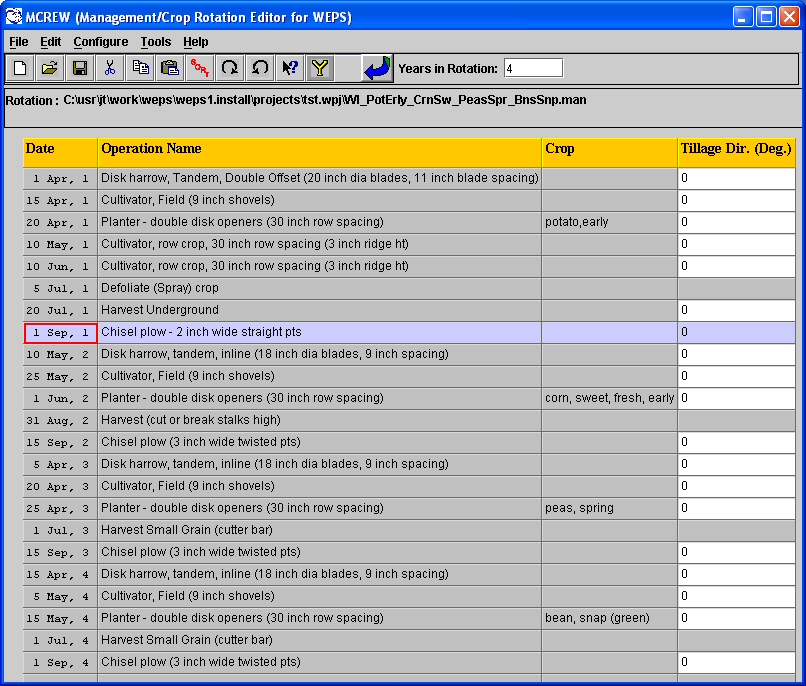
This is an example problem that we will use to evaluate a wind erosion problem in the Stevens Point area of central Wisconsin.
The scenario for the problem is:
. The farm is located near Stevens Point, WI in Portage CountyBelow (Fig. 1) is the two year rotation of Spring Peas and Snap Beans (green) including the dates and field operations. Following evaluation of the erosion rates on the two year rotation, it has been decided to set up a three year rotation to include early potatoes.

When we expand the two year rotation to include Early Potatoes, we can add the operations, dates of operation, and the potato
crop directly to the two year rotation or we can build a separate template for Early Potatoes and then insert the new template in
the rotation. We recommend the option of building a separate template for Early Potatoes and then inserting it into the existing
rotation. The new single year template for Early Potatoes begins when in MCREW by clicking on "File", then click on "New"
and this will drop a clean MCREW screen down. With the clean MCREW screen we enter dates and operations as instructed in
the earlier section on MCREW (Chapter 4). The single year cropping scenario for early Potatoes should be saved as a template.
We will save it by clicking on "file" and then "save as a template". The list of mannagement files will drop down and we will
go to the window on the bottom of the list called "File name", remove the * and then type in the name single crop scenario we
are saving. To finalize we click "Save" on the bottom right of the window. We now have a new single year template and will
add it to our two year rotation.
Below (Fig. 2) is the three year rotation of Early Potatoes, Spring Peas, and Snap Beans (green) including the dates and field
operations. Following evaluation of the erosion rates on the three year rotation, it has been decided to set up a four year rotation
to include Sweet Corn.

Figure 2. Three year rotation of Early Potatoes, Spring Peas, and Snap Beans (green).
When we expand the three year rotation to include Sweet Corn, we again, can add the operations, dates of operation, and the Sweet Corn crop directly to the three year rotation or we can build a separate template for Sweet Corn and insert the new template into the rotation. We again recommend the option of building a separate template for Sweet Corn and insert it into the existing rotation. Follow the same instruction used above for Early Potatoes to add Sweet Corn.
Below (Fig. 3) is the four year rotation of Early Potatoes, Sweet Corn, Spring Peas, and Snap Beans (green) including the dates and field operations. Following evaluation of the erosion rates on the four year rotation, it has been found acceptable.

Figure 3. Four year rotation of Early Potatoes, Sweet orn, Spring Peas, and Snap Beans (green).